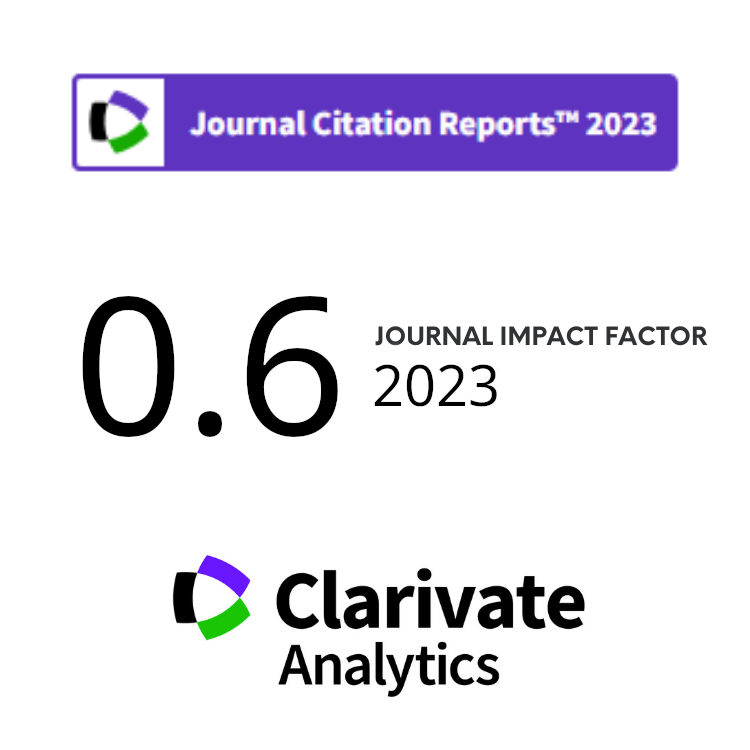Evaluation of Changes in Dose Estimation on Abdomen CT Scan with Automatic Tube Current Modulation Using In-House Phantom
Abstract
This study evaluates the effect of the Automatic Tube Current Modulation (ATCM) technique on pitch and effective diameter variation in estimating dose values and noise levels for abdominal examination on Philips Ingenuity CT scan machine using in-house Phantoms. The in-house phantoms are oval in shape with three effective diameter sizes, namely 23.2 cm, 28.3 cm, and 33.3 cm to represent abdominal region. The three size Phantoms were scanned using an Ingenuity 128 Philips CT scan with the abdominal protocol exposure parameters of 120 kVp tube voltage, Dose Right Index (DRI) variations of 10,11,12,13, and 14, and pitch variations of 0.6; 0.8; 1.0; 1.2; and 1.49. The changes in mAs, CTDIvol, and noise to the Philips reference value were then verified (i.e. an addition of one DRI value increases mAs by 12 %). For evaluation, a metric to express the change in DRI is defined as ΔDRI. The study demonstrates that noise level is influenced by object size; size information of the object could be useful to predict the change of tube current and pitch due to ATCM with respect to selected DRI. The DRI value is proportional to the tube current, thus selecting the DRI at a certain pitch will directly determine tube current. The ΔDRI in general, according to Philips specifications, is verified to be approximately 10 % to 13 %, except for DRI 10 to 11 which is relatively high on average 15 % to 17 %. Increasing DRI increases the CTDIvol. The CTDI/mAs constantly ranges of 0.06 to 0.07. The value could serve as a characteristic parameter for quality assurance. The ATCM specifications of the Ingenuity 128 CT Scanner is according to Philips regulations.
Keywords
Full Text:
PDFReferences
T. Kaasalainen, K. Palmu, V. Reijonnen et al., Am. J. Roentgenol. 203 (2014) 123.
A. Yurt, I. Ozsoykal and F. Obuz, Mol. Imag. Radionucl. Ther. 28 (2019) 96.
E. Samei, D. Bakalyar, K. L. Boedeker et al., Med. Phys. 46 (2019) e735.
L. A. Chipiga, A. V. Vodovatov, T. V. Grigorieva et al., AIP Conf. Proc. 2250 (2020) 020008-1.
A. E. Papadakis and J. Damilakis, Med. Phys. 48 (2021) 659.
N. Seo, M. S. Park, J. Y. Choi et al., PLoS One 16 (2021) e0246532.
Y. Yang, W. Zhuo, Y. Zhao et al., Appl. Sci. 11 (2021) 8961.
L. E Lubis, R. A. Basith, I. Hariyati et al., Physica Med. 90 (2021) 91.
A. M. A. Roa, H. K Andersen and A. C. T Martinsen, J. Appl. Clin. Med. Phys. 16 (2015) 350.
F. Ria, J. B. Solomon, J. M. Wilson et al., Med. Phys. 47 (2020) 1633.
C. Anam, F. Haryanto, R. Widita et al., Int. J. Radiat. Res. 16 (2018) 289.
C. J. Martin and S. Sookpeng, J. Radiol. Prot. 36 (2016) R74.
G. E. D. Camargo, G. N. Carneiro, J. V. Real et al., Radiat. Prot. Dosim. 199 (2023) 1029.
E. Setiawati, C. Anam, W. Widyasari et al., Atom Indones. 49 (2023) 61.
H. Elnour, H. A. Hassan, A. Mustafa et al., Open J. Radiol. 07 (2017) 75.
DOI: https://doi.org/10.55981/aij.2023.1315
Copyright (c) 2023 Atom Indonesia

This work is licensed under a Creative Commons Attribution-NonCommercial-ShareAlike 4.0 International License.












